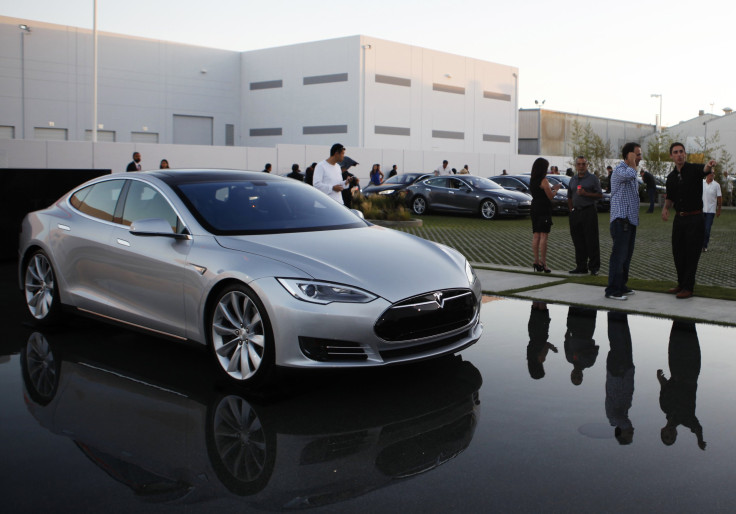Tesla Motors Shares Bounce On Analyst Upgrade: Here Are The Top Mutual Fund Investors In TSLA

A week after one investment firm downgraded Tesla Motors Inc. (NASDAQ:TSLA) from "outperform" to "neutral," another firm went the opposite direction Tuesday, upgrading the company’s stock from neutral to outperform.
Investors embraced the bullishness (big surprise) over the year’s most-hyped stock, adding more than $5 to the price of a share that was trading at under $100 in June and is now around $185. The recent upgrade is based on perceived consumer optimism for a lower-cost Tesla car that isn’t due out until 2017. But while small-time investors are piling in, mutual funds – ever the cautious stock market players – have been reducing their exposure to TSLA volatility.
TSLA has more than bounced back from that embarrassing Oct. 8 Model S fire incident south of Seattle, helped along significantly by the investment upgrade on Tuesday by Los Angeles-based investment firm Wedbush Securities, which offered the highest target price so far: $240 a share. Wedbush analysts Craig Irwin and Min Xu backed their assertion with their survey of nearly 900 people and concluded there would be mass-market appeal for a Tesla model priced around $40,000.
The Palo Alto, Calif.-based maker of the critically acclaimed Model S luxury sedan says it will release a vehicle in that price range – presumably with a Model S-like electric vehicle driving range above 200 miles – that’s been dubbed the “Gen III” and which could end up being called the Model E or the Model Y. (Tesla now owns the trademark to the following four model letters: S E X and Y. Get it?) Investors shook off last week’s investment downgrade from Milwaukee-based asset manager R.W. Baird to neutral from outperform.
Mutual funds, including six of the top 10 largest fund investors in Telsa, have collectively lowered their stakes in the company from a cumulative 53 percent to 38 percent at the end of September, according to Thomson Reuters.
Mutual funds – at least ones with whom you would want to trust your money -- often begin repositioning when a company’s stock is entering periods of volatility, selling on the upward trend. Then retail investors – pumped up on media and analysts' hype — continue to drive the stock up further until (as has been seen many times in the history of market economics) reality sets in, leaving latecomers holding the bag as the stock returns to some semblance of rational pricing.

According to the most recent filings, here are the top 10 mutual fund investors and their positions. Four have trended upward in Tesla while six have reduced their exposures. These 10 funds hold a combined 17 percent of Tesla as of their latest filings.
The fund buyers:
Boston-based Fidelity Management and Research’s Fidelity Contrafund upped its stake in Tesla by 250,000 shares in the third quarter to 3.38 million shares, or 2.78 percent. Fidelity holds about 9 percent of Tesla if you count all of its funds that hold TSLA, but it has reduced its overall stake from about 15 percent so far this year. Fidelity’s Contrafund is the only Fidelity fund that has upped its Tesla stake. Three other Fidelity funds have lowered their exposure.
Baltimore-based T. Rowe Price Group Inc. (NASDAQ:TROW) bought 2.6 million shares of Tesla, or 2.14 percent in the quarter ended June 30.
Illinois-based PowerShares Capital Management LLC’s QQQ Trust bought 1.29 million shares (1.06 percent) prior to the quarter ended Sept. 30.
Pennsylvania-based Vanguard Group Inc.’s Mid-Cap Index Fund upped its stake a slight 10,000 shares to 1.06 million (0.88 percent) as of Aug. 31.
The fund sellers:
American Funds’ Growth Fund of America dropped 20,000 shares as of June 30 to 4.69 million shares. The Growth Fund of America is the largest mutual fund investor in Tesla, with a 3.86 percent stake.
Fidelity’s Growth Company Fund dumped 220,000 shares in the quarter ended Aug. 31, lowering its stake to 2.67 million shares, or 2.2 percent.
New York-based American Fund’s Smallcap World Fund sold 370,000 shares in the quarter ended Sept. 30, reducing its stake to 1.6 million shares, or 1.32 percent.
Fidelity’s Blue Chip Growth Fund dropped 1.39 million shares of Tesla in the quarter ended Aug. 31, leaving it with 1.14 million shares, or 0.94 percent.
Fidelity’s Mid-Cap Stock Fund sold 130,000 shares in the quarter ended Aug. 31, leaving it with 1.14 million shares, or 0.9 percent.
New York-based Morgan Stanley’s Institutional Fund Trust – Mid Cap Growth sold 400,000 shares in the quarter ended July 31, leaving it with 1 million shares, of 0.89 percent of the company.
THE TAKEAWAY: Watch for further repositions from these mutual funds to get canary-in-a-coalmine hints about where they think the stock is headed -- especially any of them decide to sell.
© Copyright IBTimes 2024. All rights reserved.








